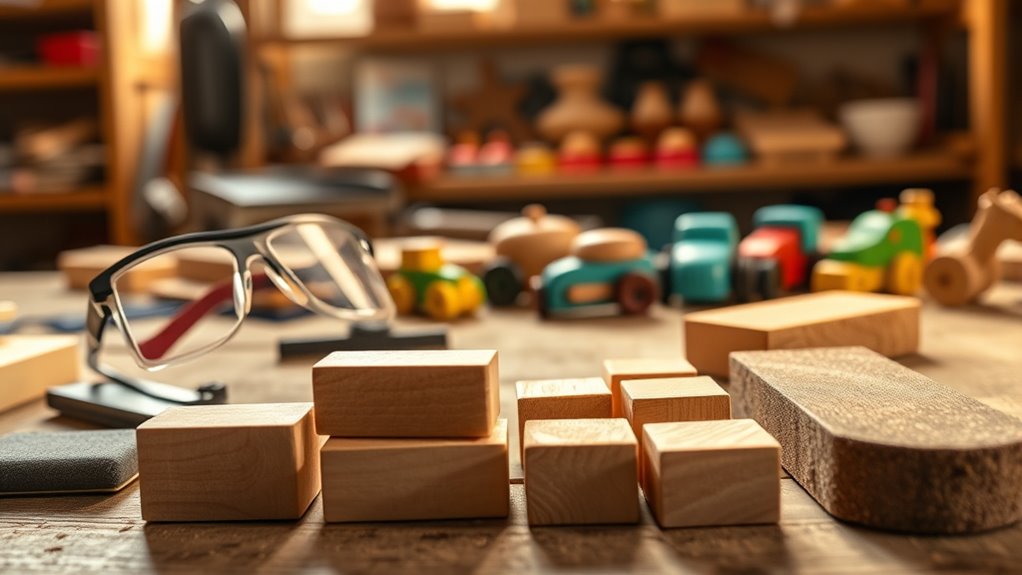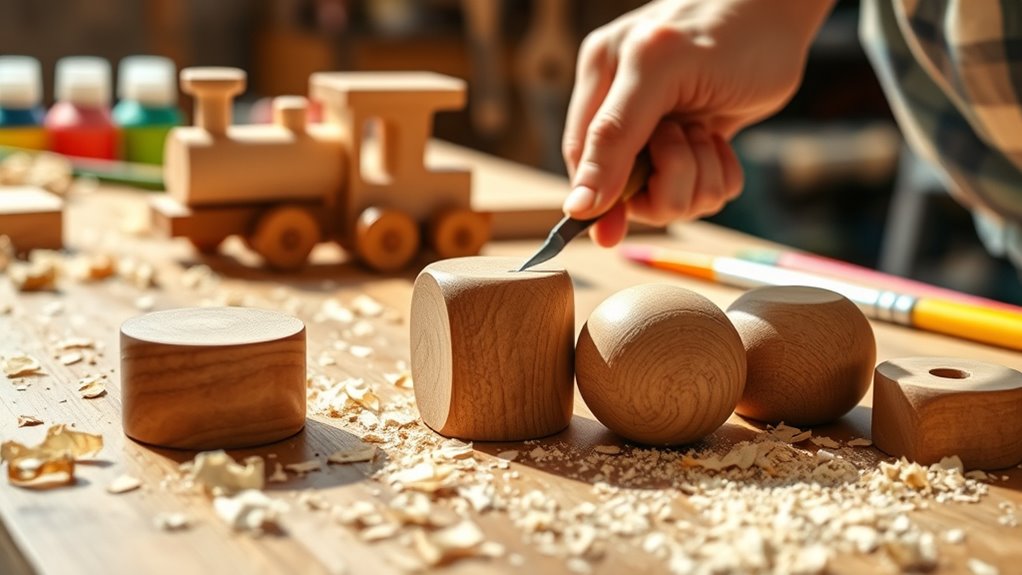When making wooden toys, guarantee you use safe, non-toxic finishes and smooth, splinter-free surfaces to protect kids. Avoid small parts that could be swallowed and design durable, well-constructed pieces that meet safety standards like those from ASTM or CPSIA. Opt for sustainable, eco-friendly materials such as FSC-certified wood. Paying attention to craftsmanship and safety features builds trust and boosts your toy’s appeal. Keep exploring these ideas to create the safest, most eco-conscious wooden toys.
Key Takeaways
- Ensure all wooden toys meet safety standards by eliminating small parts and using smooth, splinter-free finishes.
- Use sustainable, non-toxic materials like FSC-certified wood and eco-friendly, water-based paints.
- Focus on shaping rounded edges and surfaces, and thoroughly sand to prevent splinters.
- Incorporate safety features such as secure joints and avoid removable small parts to prevent choking hazards.
- Regularly test toys for durability and compliance, and maintain high craftsmanship to build trust and safety.

Have you ever wondered how to craft charming, durable wooden toys? The process involves more than just selecting the right wood and shaping it into fun shapes. Safety is paramount when making toys for children, so understanding safety regulations is essential. These regulations ensure that every toy you create is safe for little hands and mouths. They typically specify non-toxic finishes, smooth surfaces free of splinters, and the absence of small parts that could pose choking hazards. Before you start, familiarize yourself with the standards set by organizations like the Consumer Product Safety Commission or ASTM International. Compliance not only protects children but also builds trust with parents and caregivers who will buy or gift your toys. Following safety regulations also means choosing sustainable materials, which is a growing concern for environmentally conscious makers. Sustainable woods, such as bamboo, reclaimed hardwoods, or FSC-certified timber, are excellent choices. They reduce environmental impact and promote responsible forestry practices. Using sustainable materials not only aligns with eco-friendly values but also ensures that your toys are safe, free from harmful chemicals often found in less responsibly sourced woods. When selecting your materials, look for suppliers who provide documentation on the origin and treatment of their woods, ensuring they meet sustainability standards. Once you’ve chosen your sustainable wood, focus on crafting smooth, rounded edges and surfaces. Use quality sanding tools to eliminate splinters and rough patches that could hurt children. Applying non-toxic, child-safe finishes and paints is equally vital. These finishes should be free from harmful chemicals like lead or volatile organic compounds (VOCs). Always double-check product labels and opt for eco-friendly, water-based paints and finishes. Incorporating safety features into your design, such as avoiding small detachable parts, adds an extra layer of protection. It’s also a good idea to test your finished toys thoroughly for durability and safety before sharing them with children. This might include stress testing joints or checking for loose parts. Additionally, staying informed about safety standards helps you keep your toys compliant and trustworthy. By adhering to safety regulations and choosing sustainable materials, you’re creating toys that are not only delightful and durable but also safe and environmentally responsible. Your attention to these details makes your wooden toys stand out as trustworthy, eco-friendly options that parents will feel good about giving to their children. Ultimately, crafting toys with safety and sustainability in mind transforms a simple project into a meaningful contribution to children’s play and the planet’s health.
Frequently Asked Questions
What Types of Wood Are Safest for Children’s Toys?
You should choose allergen-free woods like maple, cherry, or birch for children’s toys, as they’re naturally safe and less likely to cause allergies. Opt for natural finishes such as beeswax or mineral oil instead of paints or varnishes. These woods are durable, non-toxic, and gentle for little hands, ensuring safety and longevity. Always verify that the wood is untreated or finished with child-safe, natural products for peace of mind.
How Can I Ensure My Painted Wooden Toys Are Non-Toxic?
Your painted wooden toys can be totally safe if you choose the right products. Use only non-toxic paints that are specifically labeled as safe for children, ensuring paint safety and peace of mind. Always check for low or zero VOC content and opt for natural, eco-friendly options. Applying multiple coats and letting them cure thoroughly will prevent chipping, making your toys both beautiful and safe for endless hours of play.
Are There Specific Finishes That Make Wooden Toys Safer?
Yes, there are specific finishes that make wooden toys safer. Look for non-toxic, chemical finishes like water-based paints or sealants, and natural oils such as beeswax or mineral oil. These options are free from harmful chemicals and are safe for children. Always check product labels to make sure they’re certified safe and non-toxic. Applying these finishes properly helps protect your toys while keeping them safe for little ones.
How Do I Prevent Splinters in Handmade Wooden Toys?
To prevent splinters in your handmade wooden toys, you should focus on wood splinter prevention by thoroughly sanding your toys. Use fine-grit sandpaper and employ proper sanding techniques, like rounding edges and smoothing all surfaces evenly. Always check for rough spots after sanding, and consider applying a safe, non-toxic finish to seal the wood. These steps help make certain your toys are safe, smooth, and enjoyable for children.
What Age Recommendations Should I Consider for Different Wooden Toy Designs?
You should consider age-appropriate designs based on developmental considerations when choosing wooden toys. For infants, opt for simple, large, smooth items that promote sensory exploration and avoid small parts that pose choking hazards. For toddlers, include more complex shapes and interactive features that develop motor skills. Always check manufacturer recommendations and verify the toy’s size, texture, and durability match the child’s age, fostering safe and engaging play.
Conclusion
Creating wooden toys is like building a sturdy bridge—you want it strong, safe, and reliable. Remember, even a small splinter can cause big discomfort, so always double-check your finishes. When I crafted a toy train for my nephew, I learned that attention to safety transforms a simple project into a cherished keepsake. By prioritizing safety considerations, you guarantee your handmade toys bring joy without worry, turning your craftsmanship into lasting memories for children to enjoy safely.









